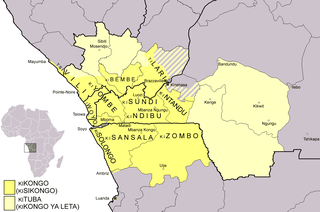Related Research Articles

Kongo or Kikongo is one of the Bantu languages spoken by the Kongo people living in the Democratic Republic of the Congo, the Republic of the Congo, Gabon and Angola. It is a tonal language. It was spoken by many of those who were taken from the region and sold as slaves in the Americas. For this reason, while Kongo still is spoken in the above-mentioned countries, creolized forms of the language are found in ritual speech of Afro-American religions, especially in Brazil, Cuba, Puerto Rico, the Dominican Republic and Haiti. It is also one of the sources of the Gullah language and the Palenquero creole in Colombia. The vast majority of present-day speakers live in Africa. There are roughly seven million native speakers of Kongo, with perhaps two million more who use it as a second language.

Michel Butor was a French poet, novelist, teacher, essayist, art critic and translator.
The Bua languages are a subgroup of the Mbum–Day subgroup of the Savanna languages spoken by fewer than 30,000 people in southern Chad in an area stretching roughly between the Chari River and the Guéra Massif. They were labeled "G13" in Joseph Greenberg's Adamawa language-family proposal. They are ultimately part of the Niger–Congo family, and have exerted a significant influence on Laal.
Valentin-Yves Mudimbe is a Congolese philosopher, professor, and author of poems, novels, as well as books and articles on African culture and intellectual history. Mudimbe is Ruth F. DeVarney Professor of Romance Studies and professor of comparative literature at Duke University and maître de conferences at the École des hautes études en sciences sociales in Paris.
Day is an Adamawa language of southern Chad, spoken by 50,000 or so people southeast of Sarh. Ethnologue reports that its dialects are mutually intelligible, but Blench (2004) lists Ndanga, Njira, Yani, Takawa as apparently separate languages.
Clémentine Faïk-Nzuji Madiya, is a Congolese poet and writer. She was born in Tshofa, Kabinda District in the Belgian Congo. Albert S. Gérard calls her "the first poet of real significance" among a group of African writers who emerged in the late 1960s; she was also the first female writer in the Belgian Congo.

The Departments of the Republic of the Congo are divided into 86 districts and 6 communes; which are further subdivided into urban communities and rural communities ; which are further subdivided into quarters or neighborhoods (quartiers) and villages. Note the departments of Brazzaville and Pointe-Noire are made of 1 commune each, then divided in urban districts (arrondissements).

Articles related to the Democratic Republic of the Congo include:
Bushi is mainly a traditional region and an African ethnic group in the eastern part of the Democratic Republic of the Congo ; mainly located in the South Kivu province. It lies along the Mitumba Mountains and includes the administrative territories of Walungu, Kabare, Kalehe, Mwenga, Idjwi and Uvira surrounding Bukavu, which is its main city. There are about 7-12 million inhabitants in the region speaking the Mashi or Shi language. The Bushi is also a kingdom that is organized into many localities or sub-chiefdoms.
Dangaléat is an Afro-Asiatic language spoken in central Chad. Speakers make up the majority of the population of Migami Canton in Mongo, Chad.
The Bongo–Bagirmi or Sara–Bongo–Bagirmi languages are the major branch of the Central Sudanic language family with about forty languages. Principal groups include Bagirmi languages such as Naba and the Sara languages. They are spoken across CAR, Chad, South Sudan, and adjacent countries.

Charles Kerremans was a Belgian entomologist who specialised in Coleoptera, especially Buprestidae and Cicindelidae.
Daniel P. Biebuyck was a Belgian scholar of Central African art.

René Debrie was a French linguist. He was born in Warloy-Baillon on 4 July 1920, and died in Amiens on 1 August 1989
The Nyanga are a Bantu people in the African Great Lakes region. Today they live predominantly in the Kivu region of the Democratic Republic of the Congo, near the frontier with Rwanda and Uganda. They speak the Nyanga language, also called Kinyanga, which is one of the Bantu languages. There are about 150,000 speakers of Nyanga according to a 1994 census, but most are also fluent in Swahili. Their national epic is the karisi Mwindo.

Achille Emile Meeussen, also spelled Achiel Emiel Meeussen, or simply A.E. Meeussen (1912–1978) was a distinguished Belgian specialist in Bantu languages, particularly those of the Belgian Congo, Rwanda and Burundi. Together with the British scholar Malcolm Guthrie (1903–1972) he is regarded as one of the two leading experts in Bantu languages in the second half of the 20th century.
The following is a timeline of the history of the city of Lubumbashi, Democratic Republic of the Congo.
The following is a timeline of the history of the city of Kisangani, Democratic Republic of the Congo.
Nyanga is a district in the Niari Department of Republic of the Congo.

Jean-Pierre Makouta-Mboukou was Congolese politician, academic, novelist and playwright. For his abundant and eclectic work his biographers have called him the “Congolese Victor Hugo” and the “baobab of Congolese literature”.
References
- ↑ Nyanga at Ethnologue (18th ed., 2015) (subscription required)
- ↑ Jouni Filip Maho, 2009. New Updated Guthrie List Online
- Biebuyck, Daniel P. and Kahombo C. Mateene (ed. and transl.) (1969) The Mwindo epic from the Banyanga (Congo Republic). Berkeley: University of California Press.
- Biebuyck, Daniel P. and Kahombo C. Mateene (1970) Anthologie de la littérature orale nyanga. Brussels: Classe des Sciences Morales et Politiques.
- Kerremans, Richard (1980a) 'Réflexes bantous en Nyanga', Études linguistiques, 2, 1, 93-110.
- Kerremans, Richard (1980b) 'Contribution du Nyanga a l'etablissement de cinq reconstructions tonales et a l'etude lexicale des langues de la zone J', in L. Bourquiaux (ed.) L'expansion bantoue, Actes du Colloque international du CNRS Viviers (France) - 4-16 avril 1977; vol. II, 415–420.
- Matheene, Kahombo C. and Komwami Mateene (1994) 'Vocabulaire fondamental nyanga', Afrikanistische Arbeitspapiere, 39, 5-54.